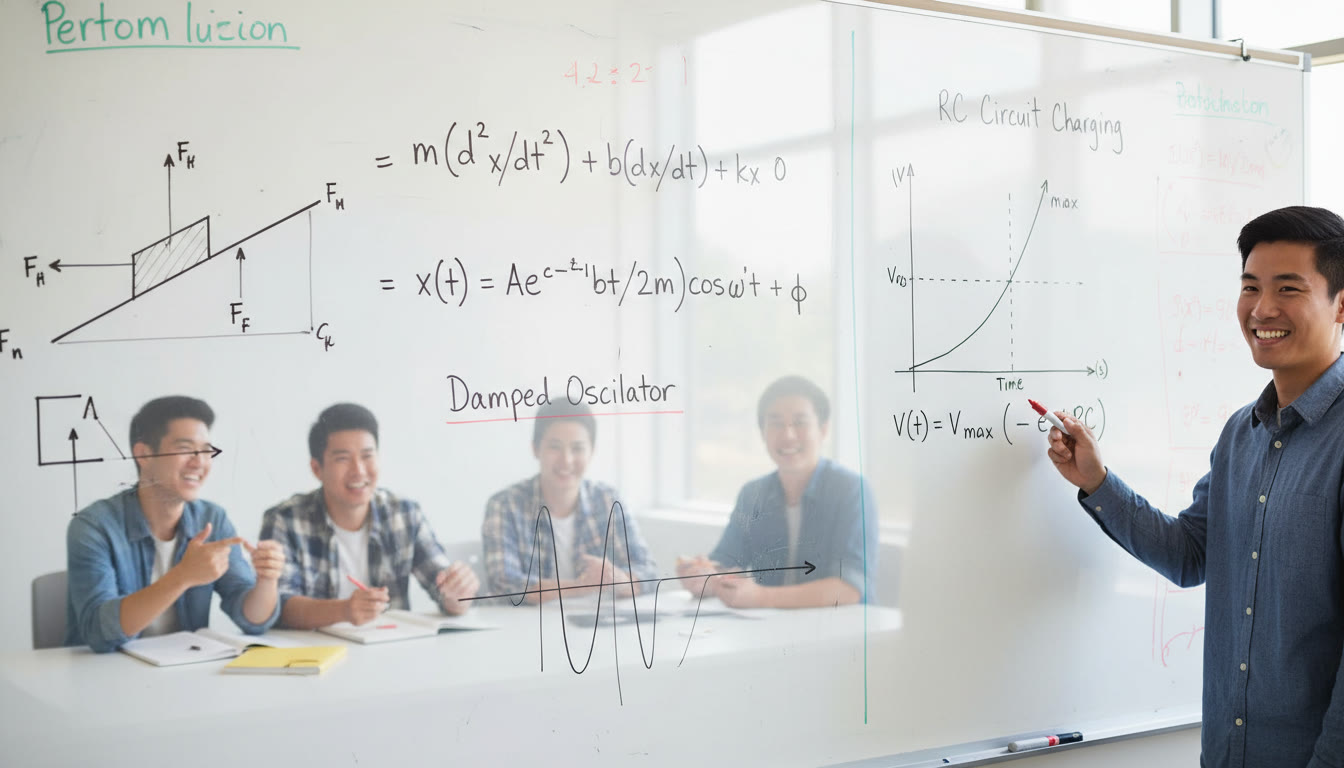Why AP Calculus AB/BC Matters for Physics C — and Why That’s Good News
If you signed up for AP Physics C (Mechanics and/or Electricity & Magnetism) you probably already sensed the partnership it forms with calculus. Good news: that pairing is not a trap — it’s an advantage. Physics C is a calculus-based course designed so that every integral or derivative you meet is a tool, not an obstacle. The trick is learning how to translate the language of AP Calculus AB/BC into the language of forces, fields, energy, and circuits.

How Calculus Appears in Physics C: A Quick Map
Before getting into strategy, it helps to know what calculus actually does inside Physics C. Here’s a quick, practical map:
- Derivatives → rates of change: velocity from position, acceleration from velocity, current change in circuits, field variations.
- Integrals → accumulation: displacement from velocity, work from force over distance, flux integrals for Gauss’s Law.
- Differential equations → modeling dynamics: harmonic oscillators, RC and LR circuits, motion with drag or variable force.
- Multivariable calculus ideas (basic) → fields and potentials that vary in more than one dimension (mostly conceptual at AP level but sometimes used implicitly).
What AP Calculus AB Covers That You’ll Use
AB-level material gives you the essentials: derivatives, basic integrals, initial-value reasoning, and applications like area and accumulation. In Mechanics you’ll use derivatives to move between position, velocity, and acceleration; you’ll use integrals to compute work and center-of-mass quantities.
What AP Calculus BC Adds — and When It Matters
BC expands your toolkit with sequences and series, parametric equations, polar coordinates, and advanced integration techniques. In Physics C, BC knowledge is especially handy for:
- Solving differential equations analytically (e.g., simple harmonic motion, exponential discharge in RC circuits).
- Working with parametric motion and angular quantities (rotation problems benefit from parametric thinking).
- Recognizing when a power series or Taylor approximation is the fastest path to an approximate solution.
Study Strategy: Turn Calculus Habits into Physics Strengths
Too many students learn calculus procedures without practicing the real habit that physicists use: moving fluidly between physical intuition and mathematical representation. Here are targeted strategies to bridge that gap.
1. Always Ask: What Physical Quantity Does This Derivative/Integral Represent?
When you see dv/dt in a mechanics problem, translate it immediately as “acceleration” and ask: what physical effect produces this acceleration? When you see ∫F · ds, read it as “work done along a path” and visualize the force and displacement.
2. Practice Small, Focused Calculus-Physics Conversions
Don’t try to do a whole exam at once. Spend 20–30 minutes on exercises that are purely conversion drills: given a physical statement, write the differential equation; given a differential equation, sketch the physical motion. Repeat until it becomes automatic.
3. Use Sketches and Physical Reasoning First
Before diving into algebra, draw the scenario. For a block on an incline with variable friction, sketch the block, forces, and how velocity will change. A quick sketch narrows down what derivatives and integrals you’ll need.
4. Solve Differential Equations Both Numerically and Analytically
Some equations are messy. Practice solving simple first-order linear ODEs analytically (RC circuit: dv/dt + (1/RC)v = source) and think about what a numerical or graphical solution would look like. On exam day, being able to interpret a sketch of solution behavior can save points.
Worked Example Walkthroughs — Calculus Meets Physics
Below are concise examples that show the mechanical process of using calculus in Physics C. Work through them with paper and pencil to get the full benefit.
Example 1: From Force to Displacement (Variable Force)
Problem setup: A force acts along x with F(x)=k x^2 (k positive). If a particle starts at x=0 with speed v0, find v(x).
Why calculus? Energy is a convenient bridge. Work done from 0 to x is ∫0^x F(x’) dx’ = ∫0^x k x’^2 dx’ = (k/3) x^3. Equate to change in kinetic energy: (1/2) m v^2 – (1/2) m v0^2 = (k/3) x^3. So v(x)= sqrt(v0^2 + (2k/(3m)) x^3).
Translation: integral of force → work → kinetic energy → solves for velocity. That chain—force to integral to energy—is a recurring motif.
Example 2: RC Circuit Transient (First-Order ODE)
Problem setup: A capacitor of capacitance C is charged through a resistor R by a step voltage V0 at t=0. Find Vc(t).
Equation: Current i = C dVc/dt. Kirchhoff gives V0 – IR – Vc = 0 → V0 – R C dVc/dt – Vc = 0. Rearranged: dVc/dt + (1/RC) Vc = V0/(RC).
Solution (standard): Vc(t) = V0 (1 – e^{-t/RC}). BC calculus helps because you’ll have practiced these exponential solutions in class; recognize the time constant τ = RC immediately and sketch the approach to steady state.
Checklist: Calculus Skills You Must Master for Physics C
Here’s a focused checklist. If any item feels shaky, prioritize it in the next two weeks.
- Derivatives and antiderivatives of polynomials, exponentials, sines/cosines, and simple rational functions.
- U-substitution and basic integration by parts.
- Solving first-order linear ODEs and simple homogeneous second-order ODEs (harmonic oscillator).
- Parametric derivatives (d/dt of x(t) and y(t)) and arc length intuition.
- Interpreting definite integrals as accumulation and area under curves.
- Series approximations for small-angle or small-parameter expansions (Taylor polynomial basics).
How to Structure a 6-Week Physics C + Calculus Review Plan
This condensed plan assumes you have ongoing AP classes and can devote focused weekly time. It blends concept review, problem practice, and timed question drills.
| Week | Focus | Key Activities | Goal |
|---|---|---|---|
| 1 | Derivatives & Kinematics | Derivative practice, motion problems, conversion drills (x <—> v <—> a) | Automatic translation between motion and derivatives |
| 2 | Integrals & Work/Energy | Work integrals, potential energy curves, energy conservation problems | Comfort computing ∫F·ds and using energy to solve for motion |
| 3 | Rotation & Advanced Kinematics | Angular derivatives, moment of inertia integrals, rolling motion | Link parametric/rotational calculus to physical rotation problems |
| 4 | ODEs in Mechanics & E&M | Harmonic oscillator, damping, simple circuits (RC, LR) | Be fluent solving and interpreting first/second-order ODEs |
| 5 | Fields and Flux (E&M) | Gauss’s law integrals, field from charge distributions, potential gradients | Comfort with surface/volume integrals conceptually and practically |
| 6 | Timed Practice & Weak-Spot Polishing | Mix of multiple-choice and free-response timed sections, review errors | Exam stamina, error pattern reduction, confident formula recall |
High-Yield Problem Types and How Calculus Helps Crack Them
Below are common AP Physics C problem types with the calculus trick that often saves time.
- Variable force across a path (use definite integrals for work).
- Non-constant acceleration (set up dv/dt or dv/dx and integrate carefully).
- Energy and potential wells (use derivatives of potential to find force: F = -dU/dx).
- Electric field from continuous charge (convert density to integrand, pick symmetry, integrate).
- Flux calculations (choose Gaussian surface or compute double integral; symmetry simplifies integrals).
Quick Tip: Choose Symmetry Over Algebra When Possible
In E&M, symmetry is your friend. Often a messy integral collapses when you pick the right coordinate system or Gaussian surface. Before grinding integrals, ask: is there symmetry that makes this trivial?
Exam Day: Calculus Routines That Save Time
On test day you won’t need to re-derive everything. Instead, follow routines that ensure speed and accuracy:
- Annotate the physical meaning of symbols on scratch paper immediately.
- For any differential equation, compute dimensions/units first — wrong units flag an incorrect setup quickly.
- When integrating, check limits and consider substitution that maps to a standard form (u-sub or trig sub frequently helps).
- For free-response, write a one-line justification linking the calculus step to a physical law (Conservation of Energy, Newton’s Second Law, Kirchhoff’s loop rule).
Tools, Resources, and How Personalized Help Makes a Difference
Self-study is powerful, but targeted guidance accelerates progress. Personalized tutoring can identify the exact calculus blindspots that cost you points and replace them with strategies tuned to your thinking style. For many students, a tutor’s role isn’t to lecture more facts but to model the mapping between calculus and physics: look at the problem this way, set up this integral, interpret the result physically.
Sparkl’s personalized tutoring offers 1-on-1 guidance, tailored study plans, expert tutors, and AI-driven insights to highlight weak areas and practice problems that yield the biggest score improvements. When you only have limited time before the exam, that kind of focused support can turn a confused topic into a reliable tool.
Smart Resource Use
- Course and Exam Description (CED) from College Board: use it to align your study plan with tested content and exam weighting.
- Past free-response questions: practice translating physical situations into calculus, then compare your solution structure to scoring rubrics.
- Timed Bluebook practice: simulate the hybrid test feel so you’re comfortable switching between digital and written responses.
Common Missteps Students Make — and How to Avoid Them
Knowing the pitfalls is half the battle. Here are recurring missteps and short corrective actions.
- Mistake: Treating calculus as pure algebra. Fix: Always attach a physical label (units and meaning) to each mathematical symbol.
- Mistake: Skipping the sketch. Fix: Make a quick diagram before equations; it reduces symbolic errors.
- Mistake: Fumbling differential equations under time pressure. Fix: Memorize solution templates for standard first-order linear ODEs and for simple harmonic motion.
- Mistake: Over-relying on calculators for symbolic manipulations. Fix: Practice solving algebraic integrals by hand to speed up conceptual steps.
Putting It All Together: A Sample Free-Response Approach
When an AP free-response arrives that mixes calculus and physics (as many do), follow this sequence:
- Read the full question once, underline specific asks and constants.
- Draw a diagram and list knowns/unknowns with units.
- Choose a principle (Newton’s laws, energy, Gauss’s law, Kirchhoff’s rules) and translate it into a calculus statement (differential equation, integral for work, surface integral for flux).
- Solve the math showing steps, but keep the physics in the narration — say what each step means physically.
- Check units and limiting cases (e.g., t→0 or large r limits) to validate your answer quickly.
Final Thoughts: Confidence Through Connection
AP Physics C rewards students who can think like both a mathematician and a physicist. The calculus you learned in AB/BC isn’t separate from physics; it’s the natural grammar that makes complex ideas precise. If you convert your calculus fluency into physical intuition—by practicing conversions, solved examples, ODE familiarity, and symmetry recognition—you’ll not only improve your AP score but deepen your understanding in a way that benefits future STEM courses.
Last practical note: mix solo study with targeted guidance. A few sessions of 1-on-1 tutoring—especially with tutors who know how to connect AB/BC calculus to Physics C problems—can collapse months of confusion into a few clear patterns. Services like Sparkl that pair tailored study plans with expert tutors and AI-driven insights are especially useful when your study time is limited and you want the most efficient path to improvement.

Quick Reference Cheat Sheet (Save This)
| Situation | Calculus Tool | Physics Interpretation |
|---|---|---|
| v(t) from x(t) | Derivative: v = dx/dt | Instantaneous speed and direction |
| Work by variable force | Integral: W = ∫ F·ds | Energy transferred along a path |
| Electric field from line charge | Integral over distribution | Superposition by integrating contributions |
| RC circuit charging | First-order ODE | Exponential approach to steady state, τ = RC |
| Small-angle approximation | Taylor expansion: sin θ ≈ θ | Simplifies pendulum to simple harmonic motion |
Ready to Start? Your Next Steps
If you’re feeling motivated, pick one small goal for tonight: either (a) work five conversion drills (physics statement → calculus expression), or (b) solve one ODE-based physics problem end-to-end and write a one-paragraph explanation linking each math step to a physical idea. Track time spent and error types; that data will show what to work on next.
Remember: mastery is not magic. It’s deliberate practice targeted at high-leverage connections between calculus and physics. With a plan, the right drills, and occasional tailored help—whether that’s a tutor who aligns with your learning style or a platform that gives structured feedback—you’ll turn calculus into your best physics tool.
Go solve something today—then explain it to someone else. Teaching is the final shortcut to understanding.
























No Comments
Leave a comment Cancel